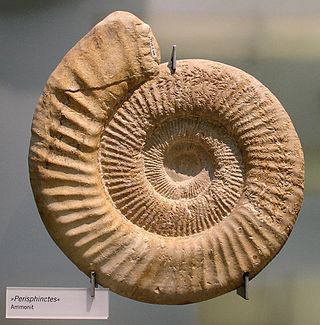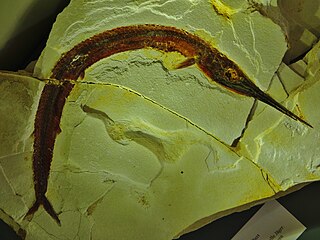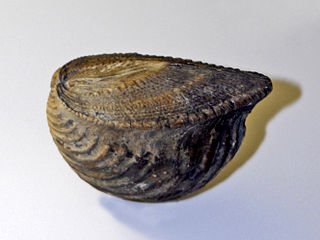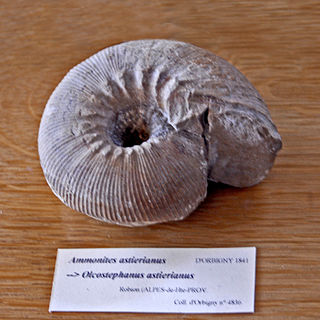
Araucaria is a genus of evergreen coniferous trees in the family Araucariaceae. While today they are largely confined to the Southern Hemisphere, during the Jurassic, Cretaceous they were dominant conifers. There are 20 extant species in New Caledonia, Norfolk Island, eastern Australia, New Guinea, Argentina, Brazil, Chile and Uruguay.

Caturus is an extinct genus of predatory marine fishes in the family Caturidae in the order Amiiformes, related to modern bowfin. It has been suggested that the genus is non-monophyletic with respect to other caturid genera.

Perisphinctes is an extinct genus of ammonite cephalopod. They lived during the Middle to Late Jurassic epochs and serve as an index fossil for that time period. The species P. boweni was named after the English chemist and geologist E. J. Bowen (1898–1980).

Inoceramus is an extinct genus of fossil marine pteriomorphian bivalves that superficially resembled the related winged pearly oysters of the extant genus Pteria. They lived from the Early Jurassic to latest Cretaceous.

Aspidoceras is an extinct ammonoid cephalopod genus belonging to the family Aspidoceratidae.
Aspidostephanus is an extinct cephalopod genus belonging to the ammonite subclass, included in the perisphinctacean family Olcostephanidae that lived during the earliest Cretaceous and possible latest Jurassic. Fossils of the genus have been found in France, the Balearics, North Africa, and Argentina.

Berriasella is a discoidal evolute perisphinctacean ammonite, and type genus for the neocomitid subfamily Berriasellinae. Its ribbing is distinct, consisting of both simple and bifurcated ribs that extend from the umbilical seam across the venter; its whorl section generally compressed, the venter more or less narrowly rounded. The species Berriasella jacobi traditionally has been regarded an index fossil defining the base of the Cretaceous, however since 2016 this had been replaced by the first occurrence of Calpionella alpina. Some authors regard B. jacobi as instead belonging to the genus Strambergella.

Belonostomus is a genus of prehistoric ray-finned fish that was described by Louis Agassiz in 1844. It is a member of the order Aspidorhynchiformes, a group of fish known for their distinctive elongated rostrums.
Austropleuropholis is an extinct genus of freshwater ray-finned fish that lived during the Late Jurassic. It contains a single species, A. lombardi, from the Kimmeridigian of the Democratic Republic of the Congo, from the terrestrial/freshwater series of the Stanleyville Formation.

Cymatoceras is a wide-ranging extinct genus from the nautilitacean cephalopod family, Cymatoceratidae. They lived from the Late Jurassic to Late Oligocene, roughly from 155 to 23 Ma.

Calliphylloceras is an ammonite belonging to the Phylloceratidae.

Zamites is a genus of sterile foliage known from the Mesozoic of North America, Europe, India and Antarctica through the Eocene of North America. It was erected as a form taxon for leaves that superficially resembled the extant cycad Zamia, however it is now believed to belong to a similar but phylogenetically different group, the cyacadeoids (Bennettitales). The fronds are linear or lanceolate in shape, and pinnately compound, with pinnae with parallel veins and smooth margins, and symmetrical and constricted at the base where they are attached obliquely to the upper surface of the rachis. It has been interpreted as a Bennettitalean plant in the family Williamsoniaceae. It is associated with the ovulate cone Williamsonia and male cone Weltrichia.

Trigonia is an extinct genus of saltwater clams, fossil marine bivalve mollusk in the family Trigoniidae. The fossil range of the genus spans the Paleozoic, Mesozoic and Paleocene of the Cenozoic, from 298 to 56 Ma.

Megatrigoniidae is an extinct family of fossil saltwater clams, marine bivalve molluscs in the subclass Palaeoheterodonta. This family of bivalves is known in the fossil record from the Jurassic period, Tithonian age, to the Cretaceous period, Maastrichtian age. Species in this family were facultatively mobile infaunal suspension feeders.

Kossmaticeras is an extinct ammonoid genus belonging to the desmoceratacean family Kossmaticeratidae. Species in this genus were fast-moving nektonic carnivores. They lived during the Late Cretaceous, from upper Turonian to upper Maastrichtian age. The type species of the genus is Ammonites theobaldianus.

Olcostephanus is an extinct ammonoid cephalopod genus belonging to the family Olcostephanidae. These fast-moving nektonic carnivores lived during the Cretaceous, from the upper Valanginian to the lower Hauterivian age.

Lithacoceras is an extinct ammonite cephalopod genus included in the superfamily Perisphinctoidea. These fast-moving nektonic carnivores lived during the Jurassic period, from the Oxfordian age to the Tithonian age.

Gaudryceras is an ammonite genus belonging to the family Gaudryceratidae.
This list, 2016 in molluscan paleontology, is a list of new taxa of ammonites and other fossil cephalopods, as well as fossil gastropods, bivalves and other molluscs that have been described during the year 2016.

Rastellum is an genus of extinct molluscs, which lived from the Middle Jurassic to the Late Cretaceous. This species is also known as Arctostrea carinata.

















